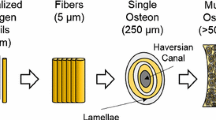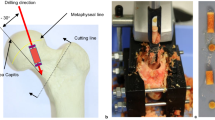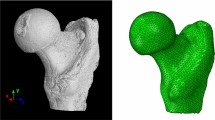Summary
In part I of this communication we reported on some time independent material properties of cancellous bone specimens from different regions of human femora. In part II we will report on our investigations of the time dependent behaviour, i.e. stress relaxation and creep. Cylindrical specimens were obtained from the head and condyles of pairs of cadaveric femora and subjected to axial loading. The data were evaluated statistically. The medianL values for relaxation of cancellous bone were greater in the femoral head than in the condyles, greater proximally than distally and greater medially than laterally in the condyles. The distribution of creep was found to be the reverse. The correlation analysis showed that a linear correlation between compressive stength, apparent density and the time dependent properties cannot be assumed.
The time dependent properties reported here would appear to demonstrate the visco-elastic behaviour of cancellous bone.
An experimental foundation and explanation is presented for the clinical practice of re-tightening cancellous bone screws one time only.
Zusammenfassung
Materialeigenschaften der Spongiosa interessieren u.a. wegen der Verankerung der Prothesen überwiegend im spongiösen Bereich des Knochens. Im 2. Teil der Arbeit über Materialeigenschaften der Spongiosa wird das zeitabhängige Materialverhalten —Kriechen und Relaxation — von zylindrischen Proben der Femurspongiosa untersucht. Die statistischen Kennzahlen fur Kriechen, Relaxation, Bruchfestigkeit and scheinbare Dichte werden für verschiedene Bezirke des Femurkopfes and der Femurkondylen angegeben. Unterschiedliche Werte für Relaxation und Kriechen wurden für die Spongiosa des Kopfes und der Kondylen gefunden. Innerhalb der Kondylen wurde medial für die Relaxation ein größerer Mittelwert und für das Kriechen ein kleinerer Mittelwert ermittelt als lateral. Die berechneten Korrelationskoeffizienten nach Bravais und Pearsson lassen bei einem Signifikanzniveau von 1% keinen linearen Zusammenhang zwischen Kriechen bzw. Relaxation und Bruchfestigkeit bzw. scheinbarer Dichte vermuten.
Die hier mitgeteilten zeitabhängigen Werte der Spongiosa zeigen das viscoelastische Verhalten dieses Materials. Zum Schluß wird experimentell belegt, warum z. B. nur ein einmaliges Nachziehen von Spongiosaschrauben sinnvoll erscheint.
Similar content being viewed by others
References
Laeis W (1972) Einführung in die Werkstoffkunde der Kunststoffe. Hauser, München
Pugh JW, Rose RM, Radin EL (1973) Elastic and viscoelastic properties of trabecular bone: dependence on structure. J Biomech 6:475–485
Rohlmann A, Zilch H, Kölbel R, Bergmann G (1980) Material properties of femoral cancellous bone in axial loading. Part I: Time independent properties. Arch Orthop Traumat Surg 97:95–102
Sachs L (1978) Angewandte Statistik, Statistische Methoden und ihre Anwendungen. Springer, Berlin Heidelberg New York, 5. Aufl.
Schönfeld CM, Lautenschlager EP, Meyer PR (1974) Mechanical properties of human cancellous bone in the femoral head. Med Biol Engng 12:313–317
Author information
Authors and Affiliations
Rights and permissions
About this article
Cite this article
Zilch, H., Rohlmann, A., Bergmann, G. et al. Material properties of femoral cancellous bone in axial loading. Arch Orthop Traumat Surg 97, 257–262 (1980). https://doi.org/10.1007/BF00380706
Received:
Issue Date:
DOI: https://doi.org/10.1007/BF00380706




